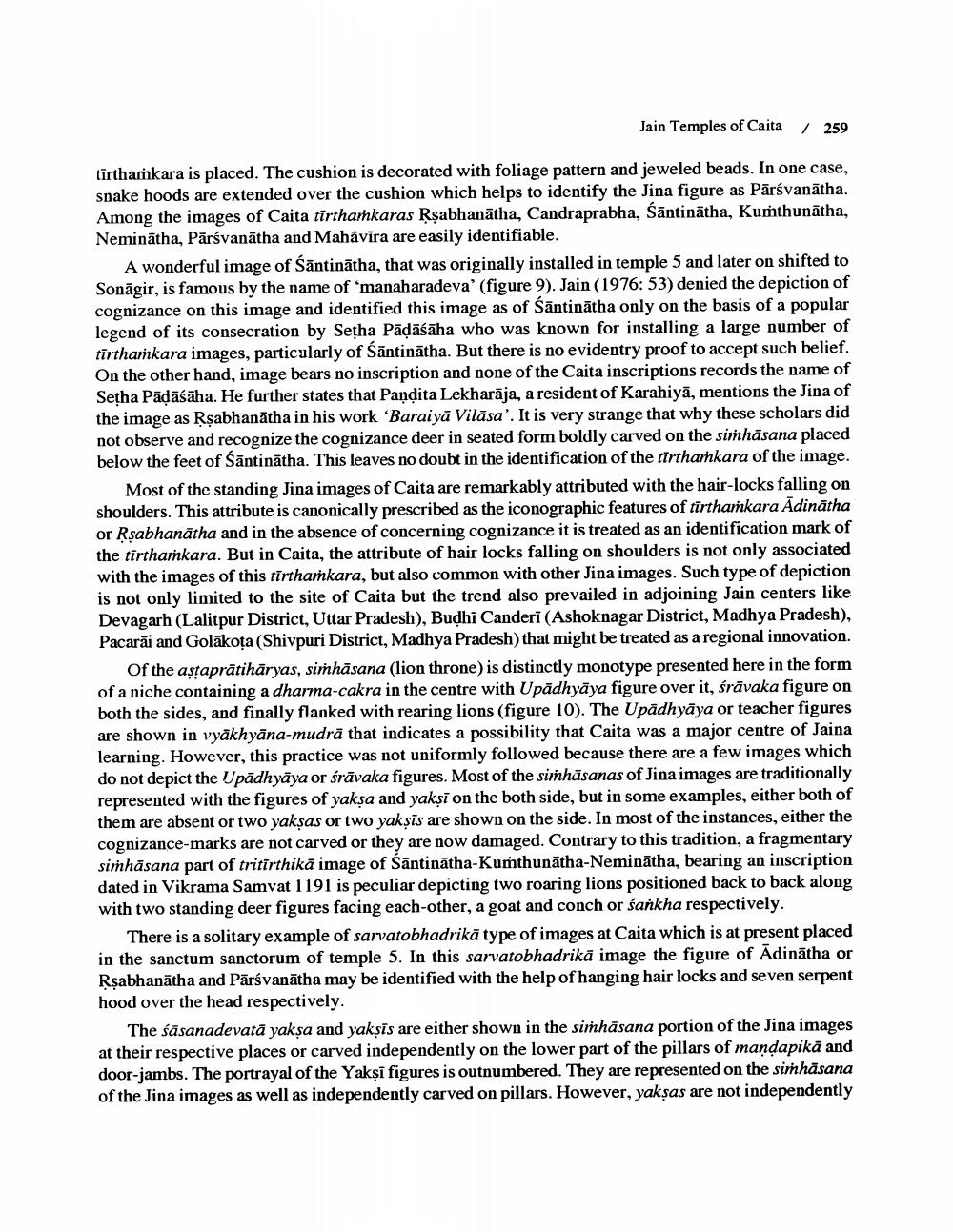________________
Jain Temples of Caita
/ 259
tīrthamkara is placed. The cushion is decorated with foliage pattern and jeweled beads. In one case, snake hoods are extended over the cushion which helps to identify the Jina figure as Pārsvanātha. Among the images of Caita tirthamkaras Rşabhanātha, Candraprabha, śāntinātha, Kumthunātha, Neminātha, Pārsvanātha and Mahāvīra are easily identifiable.
A wonderful image of Sāntinātha, that was originally installed in temple 5 and later on shifted to Sonāgir, is famous by the name of 'manaharadeva' (figure 9). Jain (1976:53) denied the depiction of cognizance on this image and identified this image as of śāntinātha only on the basis of a popular legend of its consecration by Setha Pādāśāha who was known for installing a large number of tirtharkara images, particularly of Sāntinātha. But there is no evidentry proof to accept such belief. On the other hand, image bears no inscription and none of the Caita inscriptions records the name of Setha Pādāśāha. He further states that Pandita Lekharāja, a resident of Karahiyā, mentions the Jina of the image as Rşabhanātha in his work 'Baraiyā Vilāsa'. It is very strange that why these scholars did not observe and recognize the cognizance deer in seated form boldly carved on the simhāsana placed below the feet of Sāntinātha. This leaves no doubt in the identification of the tirtharnkara of the image.
Most of the standing Jina images of Caita are remarkably attributed with the hair-locks falling on shoulders. This attribute is canonically prescribed as the iconographic features of tīrtharnkara Adinātha or Ķsabhanātha and in the absence of concerning cognizance it is treated as an identification mark of the tirthamkara. But in Caita, the attribute of hair locks falling on shoulders is not only associated with the images of this tirtharkara, but also common with other Jina images. Such type of depiction is not only limited to the site of Caita but the trend also prevailed in adjoining Jain centers like Devagarh (Lalitpur District, Uttar Pradesh), Budhi Canderi (Ashoknagar District, Madhya Pradesh), Pacarãi and Golākoța (Shivpuri District, Madhya Pradesh) that might be treated as a regional innovation.
Of the astaprātihāryas, simhāsana (lion throne) is distinctly monotype presented here in the form of a niche containing a dharma-cakra in the centre with Upādhyāya figure over it, śrāvaka figure on both the sides, and finally flanked with rearing lions (figure 10). The Upadhyāya or teacher figures are shown in vyakhyāna-mudrā that indicates a possibility that Caita was a major centre of Jaina learning. However, this practice was not uniformly followed because there are a few images which do not depict the Upādhyāya or śrāvaka figures. Most of the simhāsanas of Jina images are traditionally represented with the figures of yaksa and yakși on the both side, but in some examples, either both of them are absent or two yakşas or two yakşīs are shown on the side. In most of the instances, either the cognizance-marks are not carved or they are now damaged. Contrary to this tradition, a fragmentary simhāsana part of tritirthikā image of Sāntinātha-Kumthunātha-Neminātha, bearing an inscription dated in Vikrama Samvat 1191 is peculiar depicting two roaring lions positioned back to back along with two standing deer figures facing each-other, a goat and conch or sankha respectively.
There is a solitary example of sarvatobhadrikā type of images at Caita which is at present placed in the sanctum sanctorum of temple 5. In this sarvatobhadrikā image the figure of Adinātha or Rşabhanātha and Pārsvanātha may be identified with the help of hanging hair locks and seven serpent hood over the head respectively.
The śāsanadevatā yaksa and yaksis are either shown in the simhāsana portion of the Jina images at their respective places or carved independently on the lower part of the pillars of mandapikā and door-jambs. The portrayal of the Yakşi figures is outnumbered. They are represented on the simhasana of the Jina images as well as independently carved on pillars. However, yakşas are not independently




